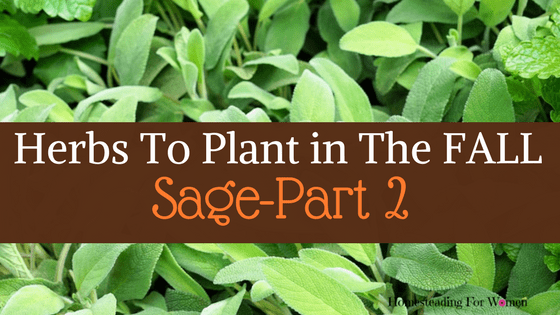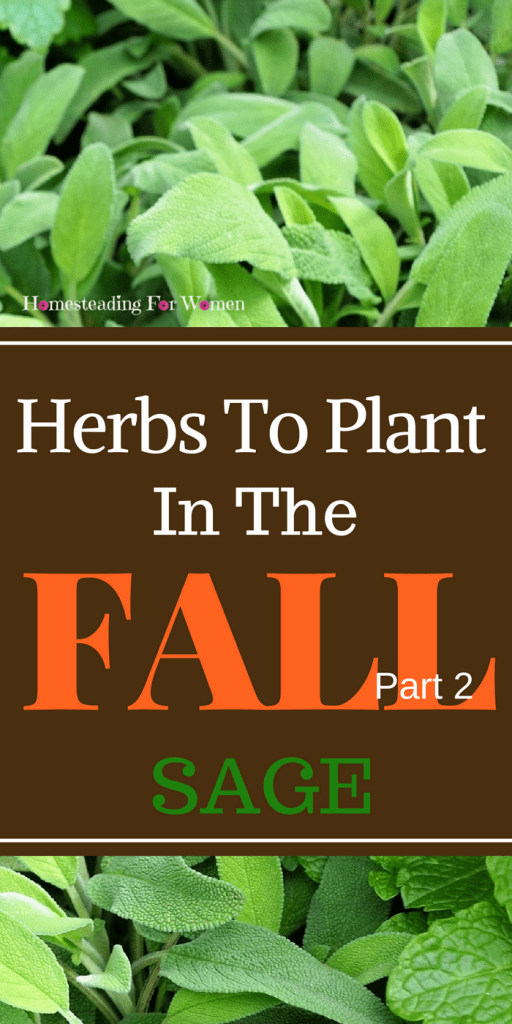Welcome to Homesteading For Women – we hope you enjoy all our tips and tricks for homestead women! Please note that we use affiliate links and ads to generate income at no cost to you.
Best Herbs To Plant in The Fall Sage

The next herb that is ideal to plant during the fall season is sage. With this herb, try to plant it as early in the fall as you can so that it doesn’t get stuck trying to grow in a harsh cold climate. Sage is a delicious herb that is really easy to use for all your culinary masterpieces. It is in the mint family, similar to basil, rosemary, oregano, and thyme.
When you get a sage plant, you will notice that it has leaves that are a green-gray color, which are edible. The leaves are the part of this plant to be used as herbs for health purposes and consumption. Here are some health benefits, ways to use sage, and of course some planting and growing tips.
Why You Should Grow Sage
You may be wondering why you would want to add sage to your fall herbs. First of all, you can of course use it to cook with. For cooking, sage is often used with meat and sausage, but can also be used to add flavor to salads. However, it is the health benefits you should really pay attention to. These are some of the top health benefits of having sage:
It strengthens your immune system – Even if you don’t get ill often, it is always a good thing when you can boost your immune system. Building up immunities means that if you come in contact with bacteria, germs, or a virus, you are less susceptible to catching that virus. Immune system boosting can also help protect your skin from various infections. You can actually use a tincture of sage to be applied to the skin on a cut or scrape in order to prevent it from becoming infected.
You can build stronger bones – Another health benefit you get from sage is to get stronger bones and protect your bone density as you age. This is a benefit you get by adding sage to your meals when cooking. Sage has vitamin K, which is an important nutrient for keeping your bone density. It can help you prevent conditions like osteoporosis. While sage won’t provide all the vitamin K you need, it definitely helps.
Sage is great for brain health – If you have trouble focusing and concentration, you might be in need of improving your brain health and cognitive function. Sage can also help with your cognitive abilities, from increasing your ability to concentrate, to improving your memory retention.
You can naturally reduce inflammation – Inflammation in the body and the skin can be very uncomfortable and often painful. It is associated with respiratory problems, gastrointestinal pain, and of course conditions like arthritis. If you have chronic pain, reducing inflammation is the first step to treating it, which you can get naturally by introducing more sage into your diet.
Ways to Use Sage
Sage has two main purposes: cooking with it and using it for holistic health purposes. Here are some different options to use your sage if you decide to grow it:
- Start cooking with your sage by adding it to soups, salads, and meats.
- Apply crushed sage herb to wounds, skin rashes, and sprains to reduce inflammation and prevent infection.
- Make a sage tincture with sage and oils to heal everything from sore throats to decreasing hair loss.
Tips for Growing Sage
If you have decided to grow sage in your backyard, it is best that you start with cuttings from a sage plant. If you are planting it in the fall, make sure it is at least 2 weeks before the winter frost. If you are in a colder climate, this means as early in the fall season as possible. You want soil to be around 70 degrees Fahrenheit, and to have good drainage. Make sure your sage is not planted near cucumbers.
Water your sage frequently when you first plant it, making sure it does not dry out. Sage is a perennial so it will keep returning year after year. Every spring, you want to prune the heavier stems to keep it healthy.
I hope you are enjoying my series on Herbs to Plant in the Fall. You might also like to read Part 1 Rosemary.

Related posts:
- Free Printable Easter Stationery: Brighten Up Your Holiday Correspondence! - March 26, 2024
- Dyeing Brown Eggs: Simple Techniques for Vibrant Easter Decorations - March 25, 2024
- Best Outdoor Artificial Flowers in Hanging Baskets That Look Real - March 22, 2024


